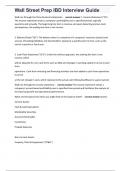Examen
Wall Street Prep IBD Interview Guide 500+ questions with all correct answers
- Cours
- Établissement
Wall Street Prep IBD Interview Guide 500+ questions with all correct answers/Wall Street Prep IBD Interview Guide 500+ questions with all correct answers/Wall Street Prep IBD Interview Guide 500+ questions with all correct answers
[Montrer plus]



